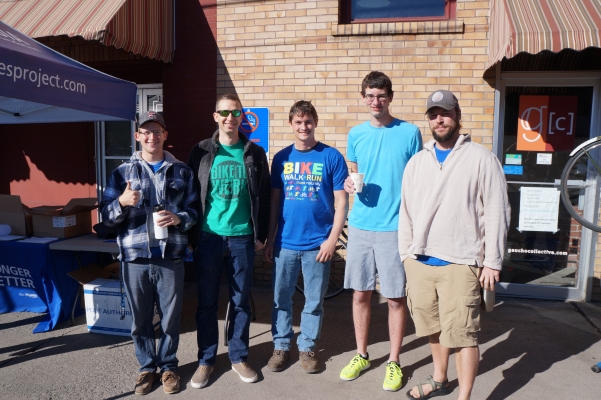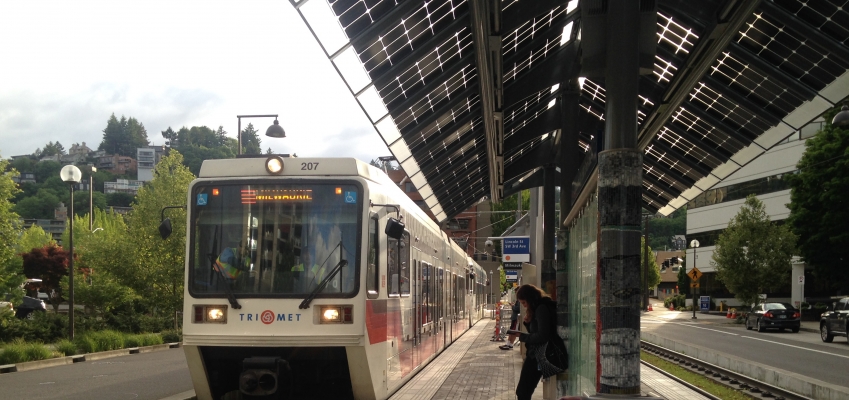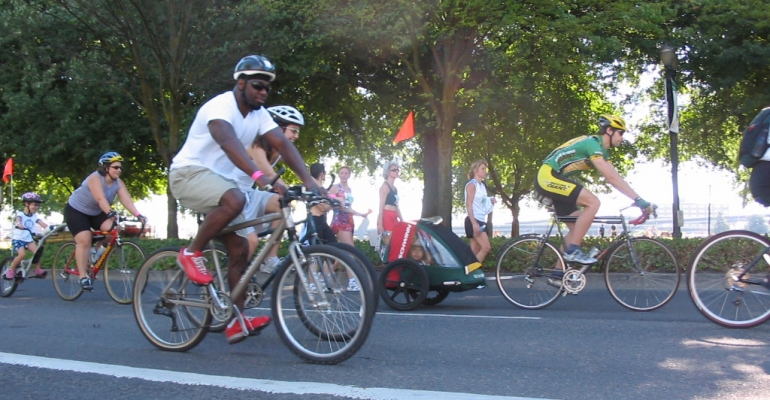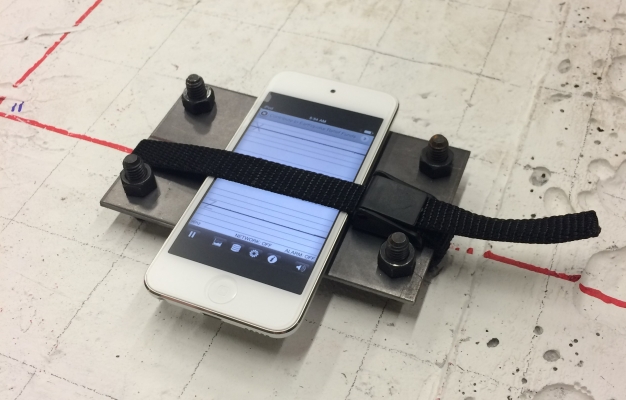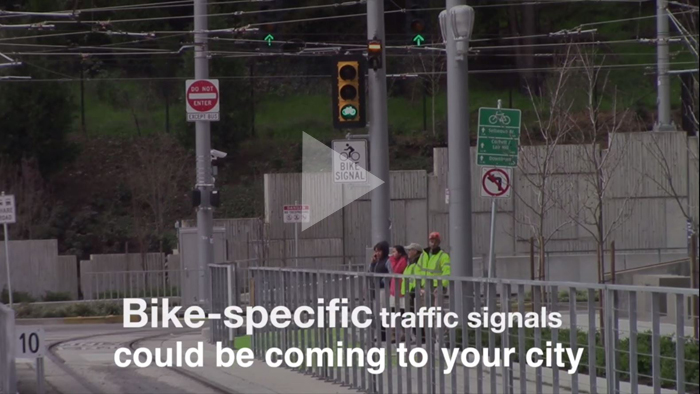May was national bike month, sponsored by the League of American Bicyclists and celebrated in communities from coast to coast.
The NITC-supported ITE student chapter at the Oregon Institute of Technology helped to organize a "Bike, Walk or Run to Work" day on Friday, May 19.
Klamath County Public Health and the Blue Zones Project partnered to bring Bike to Work events to five locations around the town of Klamath Falls, Oregon, the home of Oregon Tech.
Community members were invited to bike, walk, or run to work on May 19 and stop in at Gathering Grounds Roastery, Sky Lakes Medical Center, Mia & Pia's Pizzeria & Brewhouse, 173rd Fighter Wing, Kingsley Field, or Klamath Community College for free breakfast and refreshments.
There was also a raffle, with prize drawings at 5:.30 p.m. at Gaucho Collective.
The more participants actively commuted to work throughout the week, the more chances they had to win prizes.
Oregon Tech's ITE Student Chapter member staffed four breakfast stations across the Klamath Basin to encourage community members to consider healthier forms of transportation for their commutes.
By bringing residents, worksites, schools, restaurants, grocery stores, and government together, Blue Zones and Oregon Tech hope to inspire a community movement to improve quality of life for everyone. Bike to Work day was an indicator of that growing...
Read moreAs social media comes to permeate every aspect of modern life, public transit is no exception.
Transit agencies are increasingly making social media an integral part of their day-to-day management, using it to connect with riders about system alerts, live transit arrival information, service disruptions and customer feedback.
However, there is very little evidence to show how effective these efforts really are in achieving agency goals.
Measuring the Impacts of Social Media on Advancing Public Transit, a NITC project led by Jenny Liu of Portland State University, seeks to provide a better understanding of how transit agencies use social media and to develop some performance measures to assess the impacts of social media on promoting public transit.
This project aims to measure how social media actually impacts agency goals like increasing recruitment and retention of transit riders; increasing resources and customer satisfaction; addressing system performance efficiency; and improving employee productivity and morale.
A survey of 27 public transportation providers across the country found that although 94% of those surveyed agencies used some form of social media, only 28% had a social media plan or strategy prior to implementation.
Liu’s research explores the types of performance measures that could...
Read moreWhile bike-sharing systems become increasingly common in American cities, questions about the equity of such systems are making their way to the forefront of the conversation.
Bike share can provide a cheap and healthy means of transportation, but many systems are not serving the lower-income and minority populations who, arguably, could benefit most from having the additional travel option.
A survey of 56 bike share system operators in the United States offers an overview of how these equity concerns are being addressed.
The survey is part of a larger research effort, Evaluating Efforts to Improve the Equity of Bike Share Systems. To gain an understanding of the challenges and opportunities involved in providing more equitable bike share, TREC and NITC teamed up with the Better Bike Share Partnership: a collaboration between PeopleForBikes, the National Association of City Transportation Officials (NACTO), the...
Read moreEveryday cycling for transportation can have positive, population-level health impacts. Significant deterrents to cycling remain, however, particularly for women and minorities.
Narratives of Marginalized Cyclists, a NITC project conducted by Amy Lubitow of Portland State University, explores the experiences of women and minorities biking in Portland, Oregon.
Lubitow interviewed 28 Portlanders who self-identified as a woman or as a racial/ethnic minority (or both), and based on the insights gained from their stories, came up with a set of recommended interventions for planners to mitigate the barriers they experience.
"Institutionalized racism and sexism is hard to fix. These are complicated issues that involve multiple levels of interventions, but at a basic sort of smaller scale, there are things we can do," Lubitow said.
She chose participants who own a bike and ride it at least once a month, but not more than once a week. The primary aim of the project was to collect rich, narrative data regarding obstacles to routine or utilitarian cycling for women and minorities who already see biking as a viable form of transportation, but who make relatively few bike trips.
The interviews yielded a...
Read moreWe drive on infrastructure from the last century, never knowing when its shaking in the wind might herald a collapse, while in our hands are devices that can communicate with satellites, capture high-definition video and sense the motion of a fly. To C.J. Riley, it seemed like the one should be able to help with the other.
Riley, an associate professor of civil engineering at the Oregon Institute of Technology, is working on NITC research aimed at using low-cost, ubiquitous technology—like third-generation iPods—to evaluate the soundness of bridges and other transportation structures.
The goal of his just-published NITC education project, Dynamic Evaluation of Transportation Structures with iPod-Based Data Acquisition, was to expand Oregon Tech’s research lab while simultaneously figuring out two things: how can widely available technology be leveraged to assess structural integrity, and what is the best way to teach students this process?
To address both questions, Riley established the Structural Health and Kinetic Evaluation (SHAKE) Laboratory at Oregon Tech. While exploring options for structural assessment, Riley put some new lab tools in the hands of his graduate students: twelve third-generation iPod touch mobile devices with on-board accelerometers, Texas Instruments SensorTags, virtual visual sensors, and a...
Read more Gwen Jones, an undergraduate student at the Oregon Institute of Technology, has been awarded the 2017 Molitoris Leadership Scholarship by WTS.
Gwen Jones, an undergraduate student at the Oregon Institute of Technology, has been awarded the 2017 Molitoris Leadership Scholarship by WTS.
Jones is at Oregon Tech pursuing a degree in civil engineering with a focus on bridges and how they affect the transportation system. Over the summer, she participated in a history of bridges class, touring more than 40 bridges throughout Oregon and attending the NITC Transportation and Communities Summit in Portland, further driving her passion for bridges and her interest in the direct impact bridges have on a burgeoning transportation system.
Jones's drive, determination and confidence helped her secure the position of Director of Health and Diversity for Rogue Community College’s Associated Student Government. However, she believes her greatest leadership commitment is being a mother to her two children. As a full-time student and mother, she is driven to succeed and obtain her degree. She will graduate in 2018 with a bachelor’s degree. In addition to taking engineering classes, Gwen has accepted a position with Adkins Consulting Engineering.
The purpose of the Molitoris Leadership Scholarship is to...
Read moreGentrification is a common, and deeply controversial, outcome of urban development.
It's usually the same story: investments in new infrastructure draw the affluent, causing market forces to displace lower-income residents. Neighborhoods become renovated, and the people who once defined the neighborhood can no longer afford to live there.
NITC researcher Gerardo Sandoval shows in his latest project that it doesn’t have to be that way. With the right level of community input, transit-oriented development has the potential to bring needed services to low-income residents while revitalizing their...
Read moreA new NITC report examines factors that predict whether a driver will comply with Oregon laws aimed at keeping pedestrians safe.
Miguel Figliozzi of Portland State University, director of the Transportation, Technology & People (TTP) research lab, has done extensive work in Portland, Oregon modeling and analyzing the complex interactions between cars, transit, traffic signal technologies and human roadway users.
The research seeks to provide a better understanding of the tradeoffs between traffic mobility, transit performance and pedestrian access.
The first phase of Figliozzi’s research focused on how two advanced traffic control technologies work together. In this second phase, he zeroes in on pedestrian safety.
The report examines traffic and trajectory factors that explain whether a driver complies with Oregon law, which has strong pedestrian protections. In Oregon, drivers must stop for pedestrians as soon as they move onto the roadway in a crosswalk with the intent to proceed.
Oregon state law determines that there is a crosswalk at every intersection with or without a marked crosswalk. The state also requires that a driver, before crossing a crosswalk, stop and remain stopped for pedestrians until the pedestrians...
Read moreThe Federal Highway Administration issued an interim approval for bike signals, based on the NITC project "Operational Guidance for Bicycle-Specific Traffic Signals." The project, selected in 2015 as one of AASHTO's "Sweet Sixteen" high-value research projects, has been widely cited and the research is instrumental in beginning to standardize the use and design of bicycle signals.
This video provides a look at what that means for jurisdictions in the United States:
A new NITC report examines metropolitan centers: high-density developments in metropolitan regions.
Mixed-use transit-oriented developments are one example of a metropolitan center, but high-density developments in suburban areas without transit also fit the definition.
Across the country, metropolitan planning organizations (MPOs) are steering cities toward this type of development for a variety of reasons.
Many of them are facing the same constraints: poor air quality and increased congestion without an increase in dollars to solve it. One response to the problem involves getting a better handle on land use.
NITC researchers Richard Margerum and Rebecca Lewis of the University of Oregon and Keith Bartholomew of the University of Utah evaluated the planning process surrounding metropolitan centers in two case study regions, Denver and Salt Lake City.
“A lot of regions are paying attention to regional growth patterns. How do you do this at a regional scale when you don’t have the authority? What planners and MPOs are really facing is the question of how to support the adoption of these kinds of concepts,” Margerum said.
The goal of the study was to examine...
Read more
